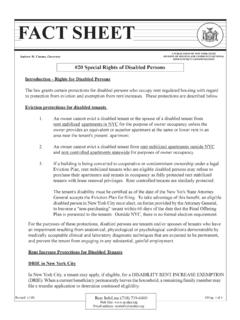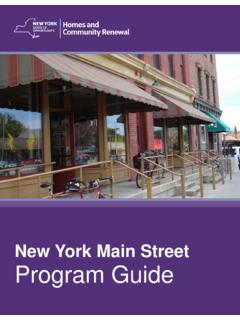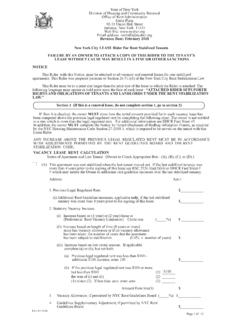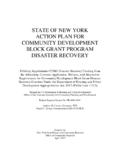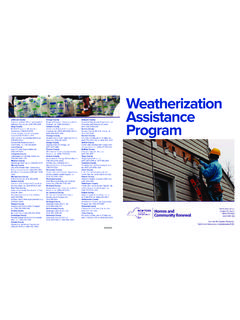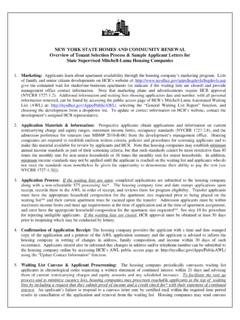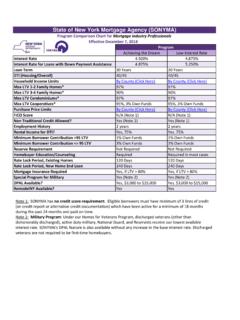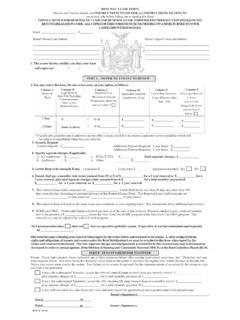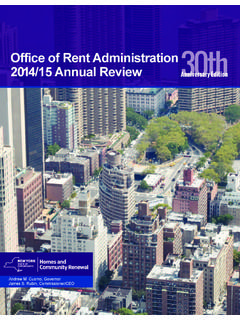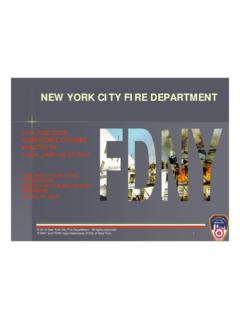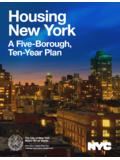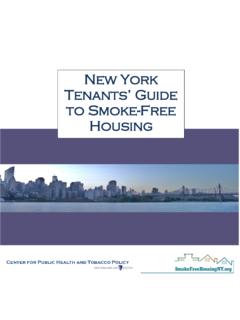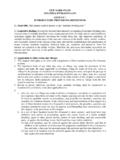Transcription of FACT SHEET - New York State Homes & Community Renewal
1 Web Site: address: InfoLine (718) 739-6400 fact SHEET A PUBLICATION OF NEW york STATEDIVISION OF HOUSING AND Community RENEWALOFFICE OF RENT ADMINISTRATIONA ndrew M. Cuomo, Governor Revised (7/17) #26 pg. 1 of 7 #26 Guide to Rent Increases for Rent Stabilized Apartments in New york City A tenant residing in a rent stabilized apartment or in a * free market/deregulated apartment that was previously rent stabilized, may make a request to the Division of Housing and Community Renewal (DHCR) for a printout of the rent registration history of the apartment .
2 The rent registration printout will show the apartment status and rents registered by the building owner with DHCR. The tenant can examine the printout along with this fact SHEET to try to determine if previous rent increases were lawful and/or if the previously rent stabilized apartment was lawfully deregulated. If the tenant believes that the rent charged or the deregulation of the apartment was unlawful, they should discuss it with the building owner. If the tenant is unable to resolve the matter with the owner, he or she may file a complaint of rent overcharge with DHCR. In examining the printout, the tenant may notice the registration of two rents in a given year, the legal rent and a lower "preferential rent".
3 A preferential rent is a rent which an owner agrees to charge that is lower than the legal regulated rent that the owner could lawfully collect. In general, existing regulations limit DHCR examination of rental histories to the four years that precede the date of the complaint. However, the Rent Code Amendments of 2014 do provide that when an owner claims that the rent being charged is "preferential", DHCR will examine the lease and rent history immediately preceding such preferential rent, even if it is before 4 years, to assure that the higher "legal" rent is correctly calculated and lawful. See fact SHEET # 40. The rent registration history printout of the apartment and the overcharge complaint form may be requested online at , by phone at 718-739-6400 or in person at a Borough Rent Office.
4 * Deregulation of a high-rent apartment may occur as follows: High-Rent Vacancy Deregulation When a tenant moves into a vacant apartment and the rent has lawfully reached the Deregulation Rent Threshold (DRT), the apartment qualifies for permanent High-Rent Vacancy Deregulation. The Rent Code Amendments of 2014 (RCA 2014) require an owner to serve the first deregulated tenant with two documents. The first is a notice created by DHCR (HRVD-N) detailing the previous rent and how the new rent was calculated. The second is a DHCR annual apartment registration, indicating the apartment status as permanently exempt and should be filed on the April 1st following the deregulation. These documents notify the tenant of their right to file a formal complaint with DHCR challenging the rent and the deregulation status.
5 High-Rent High-Income Deregulation Upon application to and the issuance of an order by the DHCR, apartments which have a legal regulated rent or maximum rent at the DRT and which are occupied by persons whose total annual federal adjusted gross incomes, as reported on their New york State Income Tax returns, have been in excess of $200,000 for each of the two preceding calendar years, may be permanently deregulated. Four (4) common ways owners may adjust rents are the following: 1. Vacancy Lease Rent Increases When a person rents a rent stabilized apartment for the first time, the owner and the tenant sign a vacancy lease. The new tenant (also called the vacancy tenant) must be given the choice of a one-or two-year lease term.
6 Generally, the rent the owner may charge for a vacancy lease cannot exceed the last legal regulated rent plus the applicable vacancy increases. Pursuant to the Rent Act of 2011, effective June 24, 2011, owners can charge and collect no more than one (1)vacancy increase in a calendar year (January 1st through December 31st). The rent may also be increased for lawful Individual apartment Improvements and/or Major Capital Improvements. With the lease, a tenant should receive a Rent Stabilization Lease Rights Rider that states how the rent was computed and asserts that any increases are lawful. The Rider was substantially revised pursuant to the RCA 2014 to include expanded reporting requirements and notification to tenants concerning Individual apartment Improvements and related rent increase calculations.
7 Based on the RCA 2014, Vacancy Lease rent increases cannot be collected if a DHCR Order reducing rent for decreased services is in effect. Copies of these orders can be obtained by filing a Request for Records Access (Form REC-1). For Vacancy Leases --Term of Lease-- Starting Between 1 Year * 2 Year * 10/1/13 - 9/30/14 20% 10/1/14 - 9/30/15 20% 10/1/15 - 9/30/16 20% 10/1/16 - 9/30/17 20% 10/1/17 - 9/30/18 20% * The Rent Act of 2015 provides that if a vacating tenant was paying a preferential rent, the vacancy lease rent increase that can be applied to the vacating tenant's legal rent will be limited to 5% if the last vacancy lease commenced less than two years ago, 10% if less than three years ago, 15% if less than four years ago and 20% if four or more years ago.
8 See fact SHEET # 40 for additional information about Preferential Rents. Rent InfoLine (718) 739-6400 Web Site: address: (7/17) #26 pg. 2 of 7 #26 pg. 3 of 7 Rent InfoLine (718) 739-6400 Revised (7/17) Web Site: Email address: Other Lawful Vacancy Increases If the owner did not collect a permanent vacancy increase within eight years of the new vacancy lease then, in addition to the percentage increase set forth above, the owner is also entitled to collect a further vacancy increase equal to percent multiplied by the number of years since the collection of the last permanent increase.
9 If the previous legal rent was less than $ per month then, in addition to such vacancy increases set forth above, the owner is also entitled to collect a further increase of $ per month. If the previous legal rent was between $ per month and $ per month, the owner is entitled to collect a vacancy increase equal to the greater of the combined vacancy increases described above or $ per month. If the owner makes improvements to the apartment while the apartment is vacant, the owner is also entitled to collect a rent increase equal to either 1/40th or 1/60th of the cost of the improvement. (See page 6 for details). This increase, known as an Individual apartment Improvement increase (IAI) is added to the rent after the vacancy increases described above, are applied.
10 Example The following example illustrates the application of some of the above rules. Tenant A paid a vacancy increase upon moving in, lived in the apartment for ten years and most recently paid a legal rent of $ per month. Tenant B moves into the apartment pursuant to a two-year vacancy lease that starts on July 1, 2016. The owner is allowed to collect a vacancy rent from Tenant B of $1, per month, calculated as follows: $800 (previous legal regulated rent) + $ ($800 x 20%) + $ ($800 x .6% x 10 years) = $ Rent InfoLine (718) 739-6400 Web Site: Email address: 2a.
